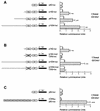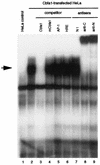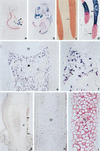Collagenase 3 is a target of Cbfa1, a transcription factor of the runt gene family involved in bone formation
- PMID: 10330183
- PMCID: PMC104402
- DOI: 10.1128/MCB.19.6.4431
Collagenase 3 is a target of Cbfa1, a transcription factor of the runt gene family involved in bone formation
Abstract
Collagenase 3 (MMP-13) is a recently identified member of the matrix metalloproteinase (MMP) gene family that is expressed at high levels in diverse human carcinomas and in articular cartilage from arthritic patients. In addition to its expression in pathological conditions, collagenase 3 has been detected in osteoblasts and hypertrophic chondrocytes during fetal ossification. In this work, we have evaluated the possibility that Cbfa1 (core binding factor 1), a transcription factor playing a major role in the expression of osteoblastic specific genes, is involved in the expression of collagenase 3 during bone formation. We have functionally characterized a Cbfa motif present in the promoter region of collagenase 3 gene and demonstrated, by cotransfection experiments and gel mobility shift assays, that this element is involved in the inducibility of the collagenase 3 promoter by Cbfa1 in osteoblastic and chondrocytic cells. Furthermore, overexpression of Cbfa1 in osteoblastic cells unable to produce collagenase 3 leads to the expression of this gene after stimulation with transforming growth factor beta. Finally, we show that mutant mice deficient in Cbfa1, lacking mature osteoblasts but containing hypertrophic chondrocytes which are also a major source of collagenase 3, do not express this protease during fetal development. These results provide in vivo evidence that collagenase 3 is a target of the transcriptional activator Cbfa1 in these cells. On the basis of these transcriptional regulation studies, together with the potent proteolytic activity of collagenase 3 on diverse collagenous and noncollagenous bone and cartilage components, we proposed that this enzyme may play a key role in the process of bone formation and remodeling.
Figures









Similar articles
-
Smad3 interacts with JunB and Cbfa1/Runx2 for transforming growth factor-beta1-stimulated collagenase-3 expression in human breast cancer cells.J Biol Chem. 2004 Jun 25;279(26):27764-73. doi: 10.1074/jbc.M312870200. Epub 2004 Apr 14. J Biol Chem. 2004. PMID: 15084595
-
Maturational disturbance of chondrocytes in Cbfa1-deficient mice.Dev Dyn. 1999 Apr;214(4):279-90. doi: 10.1002/(SICI)1097-0177(199904)214:4<279::AID-AJA1>3.0.CO;2-W. Dev Dyn. 1999. PMID: 10213384
-
High bone resorption in adult aging transgenic mice overexpressing cbfa1/runx2 in cells of the osteoblastic lineage.Mol Cell Biol. 2002 Sep;22(17):6222-33. doi: 10.1128/MCB.22.17.6222-6233.2002. Mol Cell Biol. 2002. PMID: 12167715 Free PMC article.
-
Cbfa1: a molecular switch in osteoblast biology.Dev Dyn. 2000 Dec;219(4):461-71. doi: 10.1002/1097-0177(2000)9999:9999<::AID-DVDY1074>3.0.CO;2-C. Dev Dyn. 2000. PMID: 11084646 Review.
-
Regulation of osteoblast differentiation mediated by bone morphogenetic proteins, hedgehogs, and Cbfa1.Endocr Rev. 2000 Aug;21(4):393-411. doi: 10.1210/edrv.21.4.0403. Endocr Rev. 2000. PMID: 10950158 Review.
Cited by
-
Activating enhancer binding protein 2 epsilon (AP-2ε)-deficient mice exhibit increased matrix metalloproteinase 13 expression and progressive osteoarthritis development.Arthritis Res Ther. 2015 May 12;17(1):119. doi: 10.1186/s13075-015-0648-8. Arthritis Res Ther. 2015. PMID: 25964075 Free PMC article.
-
YAP regulates the expression of Hoxa1 and Hoxc13 in mouse and human oral and skin epithelial tissues.Mol Cell Biol. 2015 Apr;35(8):1449-61. doi: 10.1128/MCB.00765-14. Epub 2015 Feb 17. Mol Cell Biol. 2015. PMID: 25691658 Free PMC article.
-
Chondrocyte-intrinsic Smad3 represses Runx2-inducible matrix metalloproteinase 13 expression to maintain articular cartilage and prevent osteoarthritis.Arthritis Rheum. 2012 Oct;64(10):3278-89. doi: 10.1002/art.34566. Arthritis Rheum. 2012. PMID: 22674505 Free PMC article.
-
MMP-13 is one of the critical mediators of the effect of HDAC4 deletion on the skeleton.Bone. 2016 Sep;90:142-51. doi: 10.1016/j.bone.2016.06.010. Epub 2016 Jun 16. Bone. 2016. PMID: 27320207 Free PMC article.
-
Regulation of NFATc2 gene expression by the transcription factor Runx2.Mol Biol Rep. 2007 Mar;34(1):1-10. doi: 10.1007/s11033-006-9001-2. Epub 2006 Nov 11. Mol Biol Rep. 2007. PMID: 17103021
References
-
- Airola K, Johansson N, Kariniemi A L, Kähäri V M, Saarialho-Kere U K. Human collagenase-3 is expressed in malignant squamous epithelium of the skin. J Investig Dermatol. 1997;109:225–231. - PubMed
-
- Anglard P, Melot T, Guérin E, Thomas G, Basset P. Structure and promoter characterization of the human stromelysin-3 gene. J Biol Chem. 1995;270:20337–20344. - PubMed
-
- Balbín M, López-Otín C. Hormonal regulation of the human pepsinogen C gene in breast cancer cells: identification of a cis-acting element mediating its induction by androgens, glucocorticoids, and progesterone. J Biol Chem. 1996;271:15175–15181. - PubMed
Publication types
MeSH terms
Substances
Grants and funding
LinkOut - more resources
Full Text Sources
Molecular Biology Databases
